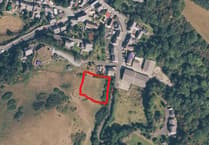A “lack of suitable and affordable housing of good quality” in Ceredigion is a continuing concern following the property ‘boom’ caused by the pandemic, a report has said, with “significant investment and work required to address the situation”.
Ceredigion County Council is currently developing a Housing Strategy for Ceredigion to run until 2028 amid ongoing concerns that residents are priced out of their communities.
The report into the early stages of the new strategy went before cabinet members on 3 October.
While no concrete plans to tackle any of the issues raised in the report have yet been made, detailed plans are set to follow after the draft report was accepted by members.
The report says “despite previous successes” of the council’s housing strategy that ran until 2023, “there continues to be a lack of suitable and affordable housing of good quality”.
“This, coupled with the need to tackle homelessness, and support the most vulnerable in our society, means that significant investment and work is required to address this situation,” the report said.
The report outlines that the spiralling cost of housing in Ceredigion since the pandemic has left the average property price up by more than 42 per cent since January 2020.
£31,162
Median household income (CACI Paycheck 2021)
£262,535
Average property price (September 2022)
A “lack of availability of suitable affordable housing options, placing increased demand on temporary accommodation,” a “small social housing sector” and a “high proportion of second homes” have led to a housing crisis in the county which means residents are left in unsuitable accommodation, unable to get onto the property ladder or even homeless.
“Ceredigion does not have a sufficiently wide range of housing stock to meet the changing needs of its residents,” the report said.
“The social housing sector is relatively small and does not meet the identified need for one and two-bedroom properties.”
The report says that “due, in part, to the Covid-19 pandemic, high demand and restricted supply has seen an increasing pressure on housing in the county, causing land and house prices to soar.
“This was as a direct result of the increased demand and, in part, to increased opportunity to work remotely.”
Even before the pandemic, the cost of housing compared to average wages in Ceredigion meant quality homes in their communities were out of reach for many residents.
Since the pandemic, however, the situation has worsened and has been exacerbated by the ongoing cost-of-living crisis.
“With lower than average earnings, Ceredigion residents also face higher than average house prices and rents,” the report said.
“The Covid-19 pandemic had a major impact on the housing market and housing affordability locally. The increase in demand combined with the limited stock has caused a mini housing ‘boom’ in the county, leading to an increase in rents.
“Local housing allowance rates are insufficient to meet the market rents in Ceredigion.
“A high proportion of the housing stock in Ceredigion is old, difficult to heat and expensive to improve to current safety and energy efficiency standards.
“Together with the cost-of-living crisis and below average earnings, Ceredigion is a prohibitively expensive place to live for many.”
Social rented accommodation in Ceredigion
Wales average for social rented accommodation
Figures in the report show that, at the end of January 2023, there were 1,750 Housing Register applications seeking social housing in Ceredigion – up from 1,400 in 2018.
On average just 280 allocations are made each year, leaving more than 1,000 residents on the register unsuccessful in getting a home.
Social housing stock accounts for just 9.4 per cent of housing in Ceredigion, compared to a Wales average of 16 per cent.
“The availability of social housing is a barrier to securing affordable housing in the county,” the report adds.
The report shows that during the ongoing crisis, its homelessness service has seen an increase in evictions.
Another issue holding back the development of new and affordable homes is the ban on development in some areas over Natural Resources Wales fears over their impact on the health of the river Teifi.
NRW produced an interim planning position statement advising that any proposals for developments within Special Areas of Conservation river catchments, in particular those that will generate increased volume or concentration of wastewater, must now prove that the design will not contribute to increased phosphate levels.
total dwellings
dwellings are second homes
“As a result, housing in some areas has stopped, which will inevitably impact on the delivery of affordable homes,” the report said.
“The council is working with all relevant partners to find short and long-term solutions to the issue to allow development to proceed and to restore the health of the rivers.”
empty properties
units of social and affordable housing to rent
The council report said: “There has been a significant increase in demand for housing in the county, causing property prices to increase by record levels.
“During the pandemic, Ceredigion saw a significant growth in property prices as demand outstripped supply. Prices began to increase as soon as the pandemic reached Wales in March 2020 and grew significantly throughout 2021.
“As a result, nationally, Ceredigion has the fourth highest Housing Affordability Ratio behind Monmouthshire, Vale of Glamorgan and Cardiff. This makes it harder for local people and first time buyers to purchase in their chosen communities, especially when considering earnings in Ceredigion are below average.”
The report concluded: “The purpose of the Local Housing Strategy is to set out a clear vision for housing within the county, along with the key priorities which identify and respond to the challenges ahead for 2023 to 2028.
“The strategy recognises the important role that housing plays together with the influence it has on the health and wellbeing of individuals, families and the wider community, and remains considerate to the Welsh language and culture.
“It is important we understand and consider the demands of future generations, their needs and how they can be catered for.
“We need houses that can be adapted, and which can sustain people at different stages of their lifetime. This will go a long way to ensure a healthier population, alongside better use of existing housing stock, and improved standards and living conditions.
“We need to provide quality housing which is suitably located which will enable people to live at home for longer; this has the potential to create more resilient and connected communities.”
A public consultation on the Draft Housing Strategy ran from 5 May to 30 June and received a total of 40 responses.




